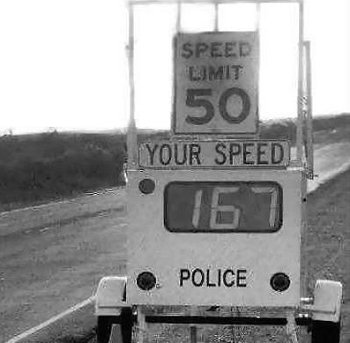Last month, an EKOS Research study for Transport Canada found seven out of 10 Canadians freely admit to exceeding speed limits from time to time, with another 11 per cent copping to speeding “only on highways.” Average speeding margins were 12 kilometres per hour over the limit on highways, 10 km/h on two-lane highways/country roads and seven km/h on residential streets.
The report contends speeders underestimate their true speed and “delude themselves” into thinking their behaviour really isn’t that bad – acknowledging they are technically breaking the law, but not in a way that endangers either themselves or others.
Perhaps the delusion is that moderate speeding poses a serious and unacceptable risk, and the real “problem” is that Canadian speed limits are too low, which 51 per cent of survey respondents said they are, and a good reason why most Canadians frequently exceed them.
 Well, there might be something to this. As someone who lives about an hour off the border, dealing with the Canadian driver, both here in the states and on their own highways is something we do frequently enough. It’s my empirical observation that I’ve very seldom passed a Canadian driver who was going slower. I observe further that on those occasions I really get blown into the weeds by a Canadian driver, the car has Quebec plates on it. Doesn’t matter what they’re driving… Mom van, sports car, SUV, skateboard, whatever.
Well, there might be something to this. As someone who lives about an hour off the border, dealing with the Canadian driver, both here in the states and on their own highways is something we do frequently enough. It’s my empirical observation that I’ve very seldom passed a Canadian driver who was going slower. I observe further that on those occasions I really get blown into the weeds by a Canadian driver, the car has Quebec plates on it. Doesn’t matter what they’re driving… Mom van, sports car, SUV, skateboard, whatever.
Here’s the kicker, though:
Following the 1973 oil crisis and the U.S. government’s imposition of a national 55 mph (88 km/h) limit, statistical analyses indicate highway safety worsened. And when Congress finally repealed federal speed limits in November 1995, to much caterwauling from the “speed-kills” crowd, with dire predictions of 6,400 increased deaths and a million additional injuries, the actual effect was diametrically opposite. Traffic deaths dropped to a record low by 1997, including in the 33 states that had immediately raised their speed limits. Meanwhile, Americans saved about 200 million person-hours in terms of less time spent on the road, with a reported net economic benefit of higher speed limits of $2 billion to $3 billion a year. A U.S. National Research Council panel pegged the cost of the 55-mph limit at about one billion person-hours per year.
Likewise, a study by the U.S. National Motorists Association found the safest period on Montana’s Interstate highways was when there were no daytime speed limits or enforceable speed laws at all. When Montana implemented a new “safety program,” imposing speed limits and enforcement, the state’s fatal accident rate didn’t just increase, it doubled, according to NMA statistics.
Other interesting findings of the Montana study were that vehicles traveling faster than average had the lowest accident rates, and there was no positive correlation between speed enforcement and accident rates on rural highways. If anything, the highways became less safe with enforcement.
It’s as I’ve said often enough; Speed laws have nothing to do with a safer public, and everything to do with making money for the state.
Tags: BitsBlog, BitsBlog, BO, Canada, Congress, hate, Kos, Men, Money, NY, oil, Sports, UN
